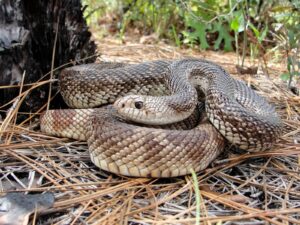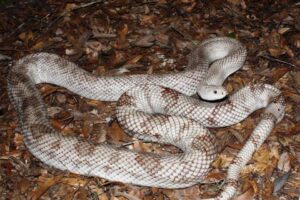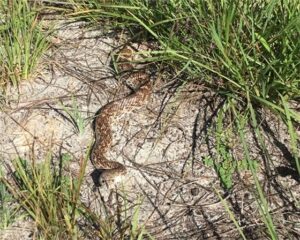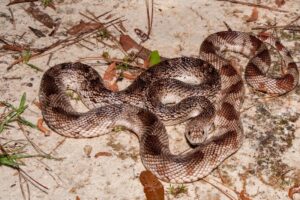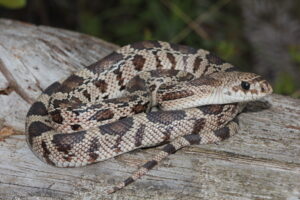Florida Pine Snake (Pituophis melanoleucus mugitus)
Updated on
25/04/2024The Florida pine snake is one of the biggest snakes in eastern North America. It is heavy- bodied and can vary considerably in size and color. Daytime is when the snake is most active – basking in the sun, foraging for food, and seeking mates (during the breeding season). But the highly fossorial species spends most of its life underground. Maximum activity of the colubrid is observed in spring and early fall.
Scientific Classifications
- Suborder:Serpentes
- Family:Colubridae
- Genus:Pituophis
- Species:P. melanoleucus
- Subspecies:P. m. mugitus
Conservation Status
Description
Size
The snake can reach a maximum length of 84 inches (213 cm).
Color and Appearance
The dorsal side of the Florida pine snake has a brown ground color with dark blotches. It has ridged scales, a white belly, and a small head with a pointed snout. The young resemble the adults in their looks, but the dark pattern is more prominent on them.
Are They Dangerous to Humans
When approached or threatened, the snake hisses loudly or makes a rattling sound by shaking its tail rapidly in dry leaves. But it is harmless to humans.
Florida Pine Snakes at a Glance
Distribution
Its range extends from southwest South Carolina, south to Florida (excluding the Everglades), and west to Mobile Bay in Alabama.
Habitat
It lives in areas having well-drained, sandy soils with a moderate to open canopy.
Its dwindling numbers can be attributed to habitat loss resulting from developmental work, and conversion of its longleaf pine community habitat to agricultural land, urban areas, and pine plantations. Road mortality and killing by humans and their pets are also contributing factors.
Lifespan
Its lifespan can exceed 15 years. The maximum recorded is 25 years.
Predators
Striped skunks, short-tailed shrews, red foxes, raccoons, domestic dogs and cats prey on the Florida pine snake.
Diet
It mainly eats rabbits, moles, rats, mice, lizards, squirrels, and other snakes and their eggs.
Reproduction
Oviparous (lays eggs that hatch outside the body)
Nests are built for laying eggs from June to August in areas with a lot of sunlight. They are made in side burrows located off the main burrow of the species. The clutch size is 4-12 eggs. The eggs hatch in September and October after an incubation period of 67-72 days. The hatchlings have an average length of 15 inches.
Source
i.pinimg.com, climateadaptationexplorer.org, srwmd.org, thumbs.dreamstime.com, live.staticflickr.com

